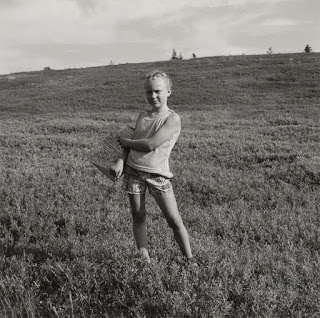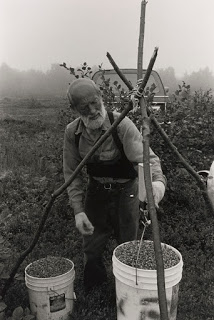Blueberry Rakers: Wild’s History on Display
PMA Show is a Tribute to Harvesting Traditions
The images are rendered in black and white, a medium that illustrates the rough-hewn world of field labor. The subjects are workers and their families who formed the Wild Blueberry raking crews. They are engaged in work and rest, framed by the foggy hills or by a field strewn with crates, or engaged in a candid moment that represents the hours spent during Wild Blueberry harvest season making a living off of the land.
 |
|
David Brooks Stess
Caledonia, circa 2000 gelatin silver print, 11 x 14 inches Courtesy of VoxPhotographs, © David Brooks Stess |
Blueberry Rakers: Photographs by David Brooks Stess is part of the Portland Museum of Art’s Circa series, which features the work of contemporary artists from Maine and beyond, and Stess’ photography, on display at the museum through May 19, features rakers on Maine Wild Blueberry fields during harvest. It is an affecting documentation of an important part of the state’s agricultural history, and ultimately, a fitting tribute to the Wild Blueberry.
The show features more than 50 gelatin silver prints which the Portland Museum of Art describes this way:
Stess has captured the physical aspects of their labor, as well as their social life in workers’ camps on the edge of the fields. By focusing his camera on the hard realities of manual labor and the relationships among the workers, Stess brings an unsentimental view to his subject.
Stess, 51, whose work has appeared throughout Maine galleries since 1995, captured images of rakers during the 20-plus year span when he served as a raker himself. Raking the naturally occurring low bush Wild Blueberry fields of Maine, Eastern Canada and Quebec was once the best way to harvest the small Wild Blueberry. And, nature has given our Wild Blueberries some unique and special attributes that make them superior to the larger cultivated blueberry that are planted and farmed all over the world. The Wild Blueberry has double the antioxidants and a delicious and complex taste that combines sweet and tangy flavors.
An Artist’s Passion for the Wild Blueberry
Stess is not shy about showing his true blue colors when it comes to the Wild Blueberry. In an article in the Portland Press Herald, he exclaimed that cultivated blueberries hardly hold a candle to the taste of wild (read about Stess’ passion for wild in Meredith Goad’s enjoyable interview, Soup to Nuts: Black-and-white and Blueberries) He also shared with Goad a genuine awe over “berry colors that vary from albino to black to different shades of red and blue”. He explains how the Wild Blueberry possesses its own “terrior” and expresses his enthusiasm for the variety of clones found in the fields, one of the unique characteristics of the Wild Blueberry (these naturally occurring varietal clones give Wild Blueberries their unique, complex flavors). And, as a fanatical pie baker and experienced farmer’s market vendor, Stess expressed the enjoyment he feels when he helps others see the connection between food and its origins.
Because the Wild Blueberry – a beloved part of the state’s culture – is central to Stess’ work, interest is high, and the exhibit set off something of a Wild Blueberry fête at PMA. The museum has included favorite recipe packets from well-known area chefs and classic institutions like Helen’s restaurant in Machias along with the show’s posters from the museum store. And for after the show, the café serves blueberry-themed items to complete the experience. And by all means, if you miss harvest season, don’t despair because 99% of the Wild Blueberry crop is typically quick frozen within 24 hours of being harvested and available in the frozen fruit section of supermarkets across the country year round.
History of Raking
Stess’ work is described as giving “a face and a context” to the iconic Wild Blueberry that is at the center of the Maine’s agriculture. His images depict the non-mechanized harvest of the fields. Hand raking, the traditional method of harvesting Wild Blueberries, began in 1910 when hundreds of laborers would come North to work fields with hand-held rakes designed to clean the plants of their fruit.
 |
|
David Brooks Stess
Norman, circa 2002 gelatin silver print, 11 x 14 inches
Courtesy of VoxPhotographs,
© David Brooks Stess |
Some small or family farms in Maine and Eastern Canada have preserved their hand-raking traditions. Members of the local community and some migrant workers still clean the fields by hand, and are paid for what they rake, often making hundreds of dollars a day on productive grounds. But hand raking represents a dwindling percentage of the millions of pounds of Wild Blueberries that are harvested today. Now, capturing Wild Blueberries at the height of taste and nutrition requires a combination of traditional and high-tech methods, and most large farms have turned to mechanized harvesting to harvest most of their land.
The integration of technology in this century-old harvesting process ensures only ripe tasty Wild Blueberries end up in the frozen bag when it gets to us. Harvesting by machine is a technologically advanced process, with harvest and cleaning equipment controlled by onboard computers. Using machines to harvest the land is efficient and can also mean less damage to the crop. It also allows growers to mow the grounds, a more environmentally sound practice than the traditional burning, and lessens farmers’ dependence on hand labor, which is increasingly difficult to find.
While the face of harvesting continues to change, many Wild Blueberry farms (Welch Farm in Roque Bluffs, for example) provide summertime tours that expose visitors to the “lost art of raking” – that sweeping of the field with the hand held rake to fill buckets to be carried to the winnowing machine for cleaning and then loaded into boxes – just as Stess’ photographs portray.
Nothing less than a rakeful of appreciation goes out to David Brooks Stess for sharing his passion for this special berry, and making the wild blueberry’s story part of his artistic vision. You can learn more about Blueberry Rakers: Photographs by David Brooks Stess at the Portland Museum of Art. You can also find out more about the history and traditions of the wild blueberry harvest at WildBlueberries.com.

